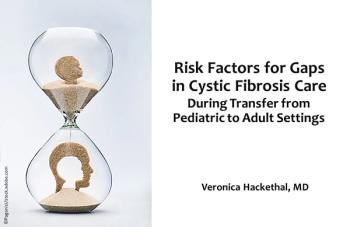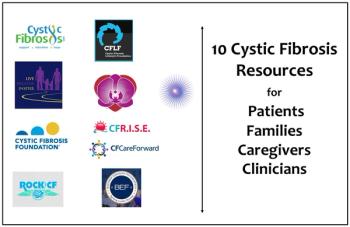
Comorbidities in Cystic Fibrosis: 10 Questions
As CF survival increases, traditional and emerging comorbidities will overlap and complicate care. Test your CF insight with our quiz.
Survival has improved dramatically in cystic fibrosis (CF), with a corresponding increase in patients who have multicomplex comorbidities, according to authors in Ireland and the UK.
In a comprehensive review published in
Most CF patients receive care at specialized clinics from multidisciplinary teams, but primary care clinicians are also integral to wholistic CF care as they promote and support general good health practices.
PCPs also should be aware of health challenges unique to this population.
To find out what you know about CF comorbidities and approaches to treating them, take this brief quiz based on the review.
1. How does the risk of pneumothorax in patients with CF who previously had a pneumothorax compare with the risk in those who did not?
A. Far lower
B. Somewhat lower
C. About the same
D. Somewhat greater
E. Far greater
Please click below for answer, discussion, and next question.
(image: ©Sebastian Kaulitzki/adobe.stock.com)
Answer: E. Far greater. The rate of pneumothorax recurrence in patients with CF ranges from 50% to 90%; 3.4% of patients with CF have had at least 1 pneumothorax. Factors that may increase risk include lower forced expiratory volume in 1 second (FEV1), pancreatic insufficiency, massive hemoptysis, allergic bronchopulmonary aspergillosis, and sputum colonization with Pseudomonas aeruginosa.
2. Which of the following are risk factors for massive hemoptysis in patients with CF?
A.Pseudomonas aeruginosa and Burkholderia cepacia complex
B. Diabetes and sputum culture positivity for Staphylococcus aureus
C. Pneumothorax and hepatic cirrhosis
D. Enteral feeding
Please click below for answer, discussion, and next question.
Answer: B. Diabetes and sputum culture positivity for Staphylococcus aureus.Pseudomonas aeruginosa, Burkholderia cepacia complex, pneumothorax, hepatic cirrhosis, and enteral feeding have been associated with a lower risk of massive hemoptysis (defined as >240 mL in 24 hours), which occurs less frequently than small volume hemoptysis. Patients with massive hemoptysis tend to be older.
3. In patients with CF, the sinuses may serve as a reservoir for pathogens that may result in lung infection.
A. True
B. False
Please click below for answer, discussion, and next question.
Answer: A. True. Dysfunction of the cystic fibrosis transmembrane conductance regulator (CTFR) gene causes thick mucus and impaired mucociliary clearance in the sinuses and results in recurrent and chronic infection and excessive inflammation. The prevalence of sinus disease findings on CT and nasoendoscopy is high among patients with CF even in the absence of symptoms.
4. What is the prevalence of pancreatic insufficiency in patients with CF?
A. ≈25% to 30%
B. ≈45% to 50%
C. ≈65% to 70%
D. ≈85% to 90%
Please click below for answer, discussion, and next question.
Answer: D. ≈ 85% to 90%. The prevalence increases with age. Because patients who previously were pancreatic sufficient may become pancreatic insufficient over time, they should be evaluated for new onset pancreatic insufficiency (an increase in GI symptoms, weight loss, and intolerance of fatty foods).
5. What is the most common nonrespiratory cause of death in persons with CF?
A. Meconium ileus
B. Hepatic steatosis
C. Hepatic cirrhosis
D. Distal intestinal obstruction syndrome
Please click below for answer, discussion, and next question.
Answer: C. Hepatic cirrhosis. Cirrhosis is an independent factor associated with death or lung transplantation in CF. Hepatic cirrhosis accounts for 2.5% of CF-associated mortality. Severe CF-related liver disease with associated portal hypertension occurs in an estimated 3% to 5% of patients with CF. The incidence is highest in the first decade of life but may decline sharply in the second decade.
6. Which factor/s have been postulated to contribute to gastroesophageal reflux disease (GERD) in patients with CF?
A. Reduced gastric motility
B. Reduced esophageal sphincter relaxation
C. Both
D. Neither
Please click below for answer, discussion, and next question.
Answer: C. Both. The prevalence of GERD in patients with CF is close to 80%. Reduced gastric motility and reduced esophageal sphincter relaxation both may be contributing factors. The risk of gastric content microaspiration is increased in patients with CF. GERD in CF is associated with an increased decline in lung function.
7. How does the incidence of acute kidney injury (AKI) in children with CF compare with the incidence observed in the general public?
A. ≈100 times higher
B. ≈250 times higher
C. ≈400 times higher
D. Slightly lower
Please click below for answer, discussion, and next question.
Answer: A. ≈100 times higher. AKI incidence in patients with CF ranges from 4.6 to 10.1 cases per 10 000 children per year. Patients with CF are at increased risk for salt loss and dehydration, which may predispose to AKI. Other risk factors for AKI include treatment with intravenous and nebulized aminoglycosides.
8. What is the prevalence of osteopenia and osteoporosisin adults with CF?
A. 8% and 5%, respectively
B. 22% and 14%, respectively
C. 38% and 23%, respectively
D. 59% and 37%, respectively
Please click below for answer, discussion, and next question.
Answer: C. 38% and 23%, respectively. Osteopenia and osteoporosis are seen frequently in adults with CF, though the prevalence may be declining over time. Factors that contribute to CF-related bone disease include pancreatic insufficiency, calcium deficiency, vitamin D and K deficiency, low peak bone mass, hypogonadism, corticosteroid use, and CF-related diabetes.
9. Malignancy is an important problem for patients with CF before lung transplantation but not post-lung transplantation.
A. True
B. False
Please click below for answer, discussion, and next question.
Answer: B. False. Malignancy has been shown to be an important problem both pre- and post- lung transplantation. In non-transplanted patients with CF, standardized incidence ratios of GI tract neoplasms appeared to be higher than in the general population. In a post-transplantation cohort, an increased risk of cancer was observed, especially for GI tract cancers, with most originating in the bowel.
10. How does the prevalence of depression in children who have CF compare with the prevalence in adults who have CF?
A. Significantly lower
B. Slightly lower
C. Slightly higher
D. Significantly higher
Please click below for answer, discussion, and next question.
Answer: B. Slightly lower. The prevalence of depression in CF ranges from 8% to 29% in children and from 13% to 33% in adults, in both cases higher than in the general population. Factors that may increase the likelihood of anxiety and depression in patients with CF include lower FEV1, poorer treatment adherence, poorer quality of life, and more frequent hospitalizations.
_______________________________________________Stay in touch with Patient Care® Online
→
→ Like us on
_______________________________________________
Newsletter
Enhance your clinical practice with the Patient Care newsletter, offering the latest evidence-based guidelines, diagnostic insights, and treatment strategies for primary care physicians.



















































































































































































































































































